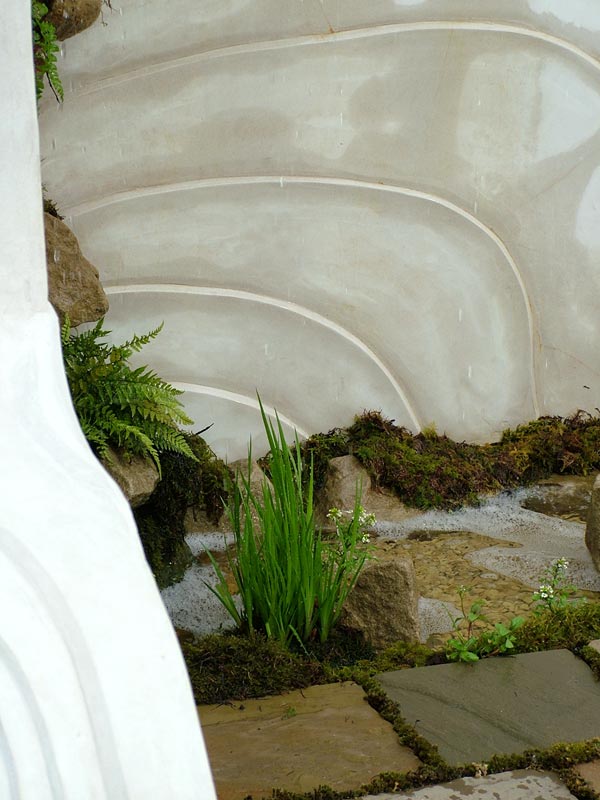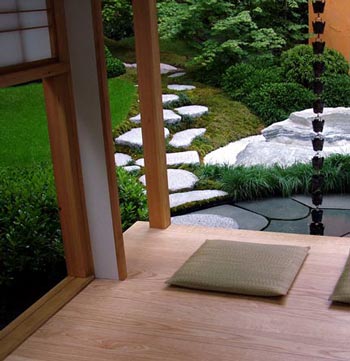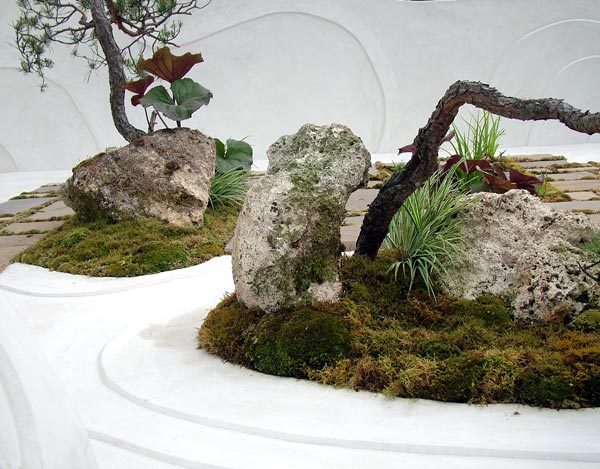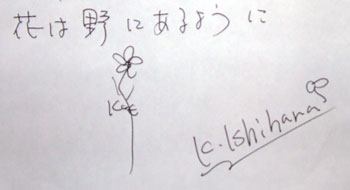Japanese Gardens

Perfectly Simple
I was particularly looking forward to the Japanese gardens at Chelsea: the unique simplicity of Japanese garden design is so stylish, serene and absorbing, and very much-missed by this ex-resident of Japan. The three Japanese gardens at Chelsea lived up to expectations, and the judges clearly agreed, awarding high medals to the first-time exhibitors.
Each of the designs incorporated the four fundamental elements of a Japanese garden - water, stones, plants and the senses - yet were quite different from each other. Vast crowds formed around the Oriental exhibits, appreciating their striking distinction from the other Chelsea designs.
Unlike many of the other gardens at Chelsea, it seemed right to not to enter the Japanese exhibits; the designs did not beckon the visitor in to explore, merely to stand aside an appreciate, like a piece of fine art. Although this seemed fine at a view-only flower show, I wonder how many of the observing gardeners felt inspired or confident to take the ideas back to their own gardens?

Dry Stone Stream under House
Shizen - The Japanese Way
The UK Japanese Garden Society Show Garden entry was on a winding path away from the hubbub of the show's main area, which increased a sense of having 'found' the peaceful exhibit. The garden surrounded a Japanese-style house, the immaculate lawn bordered by a simple palette of foliage plants from the Kansai (southern) region.
The four fundamental elements (water, stones, plants, the senses) blended effortlessly in this classic design by the president of the society, Maureen Busby. As the name suggests, the garden illustrates the Japanese way of creating a living space harmonious with nature, by blurring the boundaries between the house and its surrounding garden. The rain-chains funnelled rain water from the roof into the pool by the veranda, the stone paths ran underneath the house, and the paper sliding screen walls (shoji) opened onto different parts of the garden, creating and framing different views.

Cushions to appreciate the view
Stone-work drew the eye across the garden : a dark-grey, chunky gravel stream flowed under the house, out into the shallow pool of water; three chunks of rock sat symbolically on the neighbouring pale, dry gravel pool; roughly-hewn paving slabs then took the gardener away into the lawn.
The plant list has a few echoes of Moosey's - Iris Japonicas, Ginkgo Biloba, Deutzia, Camellia, Pittosporum and a host of Rhododendrons. A few blue lilies by the house add a dash of colour. The bordering hedge was a blanket of perfectly-trimmed little shrub baubles.
This observing non-gardener certainly wanted to bring this perfect little garden home, though perhaps only if someone else would maintain it for me...
Minamoto
The Chic Garden's neo-Japanese entrant certainly sat well in the category. The garden was chic simplicity - white sculptured sandstone boundary walls; paving stones winding between small water features; minimal, typical Japanese plantings of maples, ferns, mosses and bamboo. The effect was dramatic and serene, an instant favourite with us and the admiring crowds.

A Minimalist neo-Japanese Chic Garden

Collecting Autographs
The designer, Ishihara Kazuyuki, is well known in Japan, appearing on TV and radio. He was clearly very enthusiastic to talk about his work so it was unfortunate that he could only speak through a translator. I managed to stumble out some basic Japanese - "Congratulations on your medal", "Your garden is wonderful", "Could I have a leaflet?" - and in response the designer signed his trademark phrase on a leaflet for me. Nice! I think it says "the flowers belong to the field" - as with all good proverbs, it's hard to translate. (Especially with a Japanese reading age of six.)
Niwazare
The City Garden Best in Class winner seems the softest, most usable of the three Japanese gardens at Chelsea 2004. The countryside in Wales reminds the designer Yano Tea of Japan, so she combined the two themes in her design. The letter H and a Japanese writing character ('he' in Hiragana?) provide the lines, and the traditional four elements mix well with contemporary materials, like stainless steel mirrors reflecting the movement of the plants in the wind.
I am gutted that we missed this garden - we missed the whole City Garden strip, in fact. Next year we will be more vigilant!

An Expertly-Grown Old Bonsai Tree
Ikebana & Bonsai
We saw a couple of Bonsai displays as we whizzed through the Great Pavilion - some of the elegantly displayed trees were (relatively) huge, nearly 60 years growth and worth many thousands of pounds.
The London School of Ikebana also had a great display of Japanese flower-arranging - the asymmetrical, minimalist and highly crafted arrangements were a light relief from the showy bonanza of flowers all around.
If you're passing...
A tourist doesn't need to search far to experience beautiful gardens in Japan. Unlike the incidental beauty which a churchyard affords a typical English village church, Japanese gardens are part of the temple, a place of worship and reflection. The time and effort put into maintaining the gardens is admirable, and the fantastic results are open for visits all over Japan. A must-see!